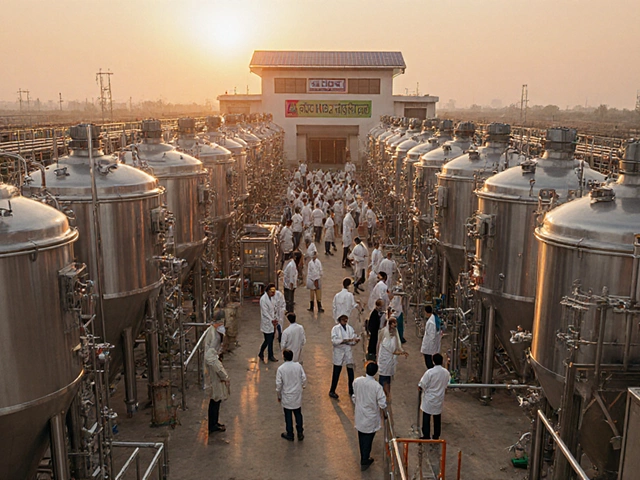
Think about your phone, your laptop, or your car. Chances are, the tiny chips powering them come from one company: TSMC. They’re the Apple of the semiconductor world, cranking out over half of the world’s advanced logic chips. But for all India’s talk about becoming a tech and manufacturing giant, TSMC hasn’t bitten yet when it comes to setting up shop here. Why not?
India's government has rolled out big cash incentives, slashed red tape (at least on paper), and pitched 'Make in India' as the next big thing. They’re waving billions of dollars at chipmakers, TSMC included. Yet, the response from TSMC? Radio silence. No new plants, no big investments, not even a firm commitment. There’s a real sense of frustration in India’s tech scene — what’s stopping the world’s biggest chipmaker from jumping in?
- TSMC: The Chip Powerhouse
- India’s Big Pitch and Real Hurdles
- Why TSMC’s Eyes Are Elsewhere
- What India Can Do Next
TSMC: The Chip Powerhouse
When you hear about global chip shortages or next-gen tech, TSMC is always in the mix. Short for Taiwan Semiconductor Manufacturing Company, this giant makes chips for brands like Apple, AMD, Nvidia, and Qualcomm. They’re not just big—they’re essential. If TSMC stopped, your smartphone, PC, and most cars would have massive problems.
Let’s look at why TSMC holds all the cards.
- TSMC controls over 50% of the global foundry market. That means half of the world’s companies that need chips go to them.
- They’re the only ones, besides Samsung and Intel at a much smaller scale, able to mass produce at cutting-edge 3nm tech.
- Nearly every top smartphone uses TSMC chips. In fact, Apple’s entire A16 and M-series processors are “fabbed” in TSMC’s Taiwan facilities.
Take a look at some numbers. These don’t lie:
| Year | Revenue (USD) | Market Share (%) |
|---|---|---|
| 2022 | $75.9 Billion | 56 |
| 2023 | $69.3 Billion | 60 |
What makes them so hard to compete with? It’s not just size—it’s the super-advanced fabs (the technical name for chip factories). Building one fab can cost $10–20 billion. And once built, getting those chips right at the smallest scale (think billions of transistors on a chip smaller than your fingernail) takes skills, patents, and lots of experience.
If you’re in the electronics manufacturing game and want the best chips, you end up at TSMC’s door. This clout gives them the power to choose exactly where they invest and expand—and they’re picky for good reasons.
India’s Big Pitch and Real Hurdles
India has been hustling to get TSMC’s attention. The government rolled out a $10 billion semiconductor incentive scheme in late 2021, promising up to 50% in subsidies for anyone willing to set up a wafer fab. The same time, they cut import duties and streamlined some of the usually brutal licensing processes. Fresh zones called Electronics Manufacturing Clusters even guarantee ready-to-use infrastructure. On paper, India is saying, "Bring your machines, and we’ll do the rest."
But the reality is stickier. Setting up a semiconductor manufacturing plant (or "fab") is brutal business. It’s not just about money—though, let’s be clear, it’s insanely expensive. You also need rock-steady electricity, gallons of super-pure water, a reliable supply chain, and a talent pool used to this kind of work. India is getting better, but it’s not there yet. Power outages happen every other month in some states. Ultra-pure water? Hard to find in many industrial parks. And hiring experienced engineers? Tough, because most of the seasoned chip folks still work overseas, or for companies like Intel, Samsung, and, yes, TSMC, but in Taiwan or the US.
Check out how India stacks up on some key fab needs:
| Requirement | India | Taiwan |
|---|---|---|
| Power Reliability | Unstable in most regions | 95%+ uptime |
| Ultra-pure Water | Limited access | Readily available |
| Skilled Chip Engineers | Shortage | Abundant |
| Robust Supply Chain | Still developing | Mature |
TSMC is super picky for a reason—their margin for error is almost zero. They need flawless support systems, not promises. Even if the Indian government throws cash at the problem, that alone can’t build the ecosystem overnight. The truth? India is on the right track, but these gaps are why big names aren’t lining up yet.

Why TSMC’s Eyes Are Elsewhere
You’d think with all the buzz around India’s market and tech talent, TSMC would be all over it. But right now, they’re parking their money and know-how in places like the US, Taiwan, and Japan. There are some simple reasons, and they’re not just about money—it's about trust, speed, and safety.
Chipmaking isn’t just cutting-edge science. It’s expensive and high-stakes. A basic advanced fab (factory) runs about $10–15 billion, and every tiny hiccup—power cut, water shortage, a missed shipment—can cause a disaster. TSMC likes safe bets. That means reliable electricity, loads of clean water, and a supply chain that actually works day in, day out. India is working on these things, but TSMC’s used to places where the basics are totally locked down. In Arizona, for example, TSMC is getting crazy tax breaks and guaranteed utility support. Meanwhile, India still faces power blackouts and water worries in its industrial hubs.
Another point: TSMC wants skilled workers who know chips like the back of their hand. India has top engineers, but not enough folks with years of hands-on chip fab experience. Taiwan, Japan, and even the US already have people who’ve done this for decades. Building that local workforce in India would take years, and TSMC just doesn’t want to risk downtime training everyone from scratch.
Then there’s the question of geopolitics. TSMC has deep ties with the US, which is slapping export bans and restrictions on China and wants chips made at home. The US government has even set aside over $50 billion in incentives through the 2022 CHIPS Act to get companies like TSMC building fabs on American soil. India’s incentives are big, but they don’t come with the same strategic pull. The Japanese government is also throwing money at TSMC to set up shop, and Japan has legendary supply chain reliability.
Check out how recent TSMC investments stack up:
| Country | Year Announced | Investment ($B) | What’s Special? |
|---|---|---|---|
| USA (Arizona) | 2020 | 40 | CHIPS Act, stable infra, skilled workforce |
| Japan (Kumamoto) | 2021 | 8.6 | Government funding, supply chain |
| Taiwan | Ongoing | N/A | Home base, existing infrastructure |
| India | - | 0 | Still at negotiation stage |
So, it’s clear—TSMC isn’t ignoring India forever, but with current conditions, they’re just not ready to gamble on a market that still has too many moving parts. Their focus, for now, is on places that already have what they need to crank out the world’s fastest chips with no drama.
What India Can Do Next
For India to attract players like TSMC, a change in strategy is needed. It’s not just about throwing cash or announcing new schemes. TSMC wants stability, top-level technical know-how, and a supply chain that runs like clockwork. What’s working against India? Right now, there’s not enough chip design talent, the power supply isn’t reliable, and most suppliers that TSMC needs aren’t in place locally.
Let’s look at some numbers to get the picture clear. Check this quick table that shows where India stands compared to established chip-making hubs:
| Country | Electricity Reliability (Avg. Annual Outages) | Semiconductor Fab Suppliers (2024) | Skilled Engineers (Per 1,000 People) |
|---|---|---|---|
| Taiwan | Just 1-2 hrs | 300+ | 5.6 |
| India | 15+ hrs | Under 50 | 1.8 |
| USA | 0.5 hrs | 250+ | 4.7 |
The gap isn’t small. Here’s what leaders and policymakers in India could actually do that matters:
- Invest in people first. More chip design and fabrication training programs in universities and technical institutes are a must. Internships with global chipmakers will help too.
- Sort out the basics: Power and water. Chip fabs need stable, clean energy and huge amounts of water. Setting up dedicated zones for electronics manufacturing with guaranteed infrastructure is key.
- Grow the local supply chain. TSMC depends on hundreds of specialized suppliers. India needs to invite and support top suppliers to set up shop, maybe with joint ventures or tax breaks.
- Speed up government decision-making. Investors get nervous when permits or approvals take too long. Create a single-window system: one place to handle all paperwork, with clear deadlines.
- Negotiate directly with tech giants. Sometimes the personal touch makes a difference. Senior Indian officials and business leaders should hold direct talks at TSMC’s HQ, not just send letters or announcements.
Japan offered land and $4 billion in cash to TSMC and got a major fab in return—India has to be just as bold, but even more prepared. If these basics are fixed, don’t be shocked if the world’s biggest chipmaker finally gives India the green light.




